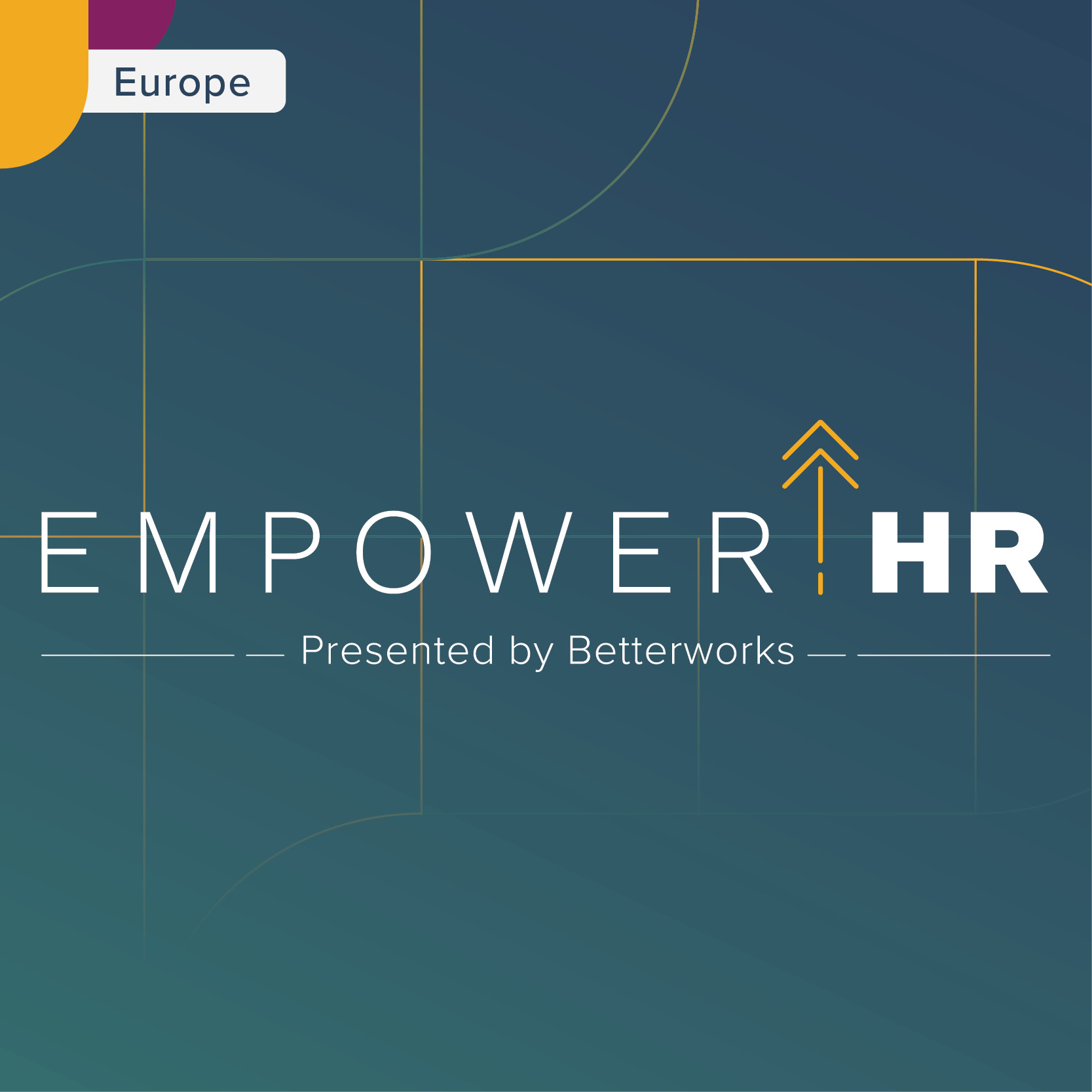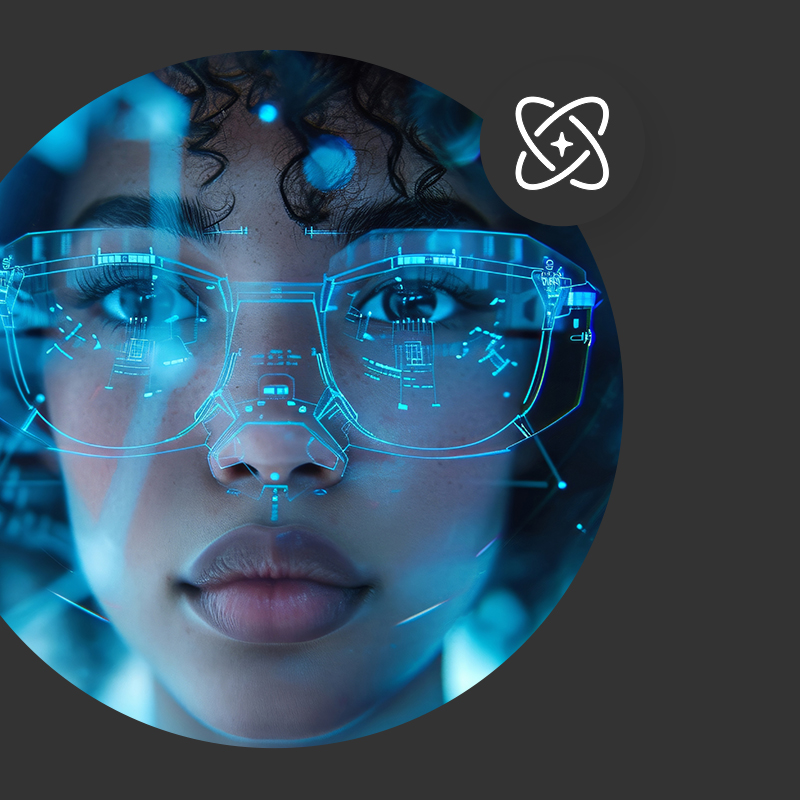Employees quit for all kinds of reasons — a dead-end in career growth, ineffective managers, rigid work policies, and feeling undervalued. Now there’s a new factor to add to that list: uneven adoption of AI in the workplace. Betterworks’ 2025 State of Performance Enablement report highlights a growing divide between AI-savvy employees and everyone else that’s creating a new retention threat.
The troubling part? Those AI superusers tend to be high performers — and they’re more likely to have one foot out the door. Nearly 8 in 10 highly engaged employees (non-HR managers and individual contributors) who are AI superusers — meaning they use AI daily or weekly — are actively seeking new opportunities, while 65% of less engaged individual contributors plan to stay put.
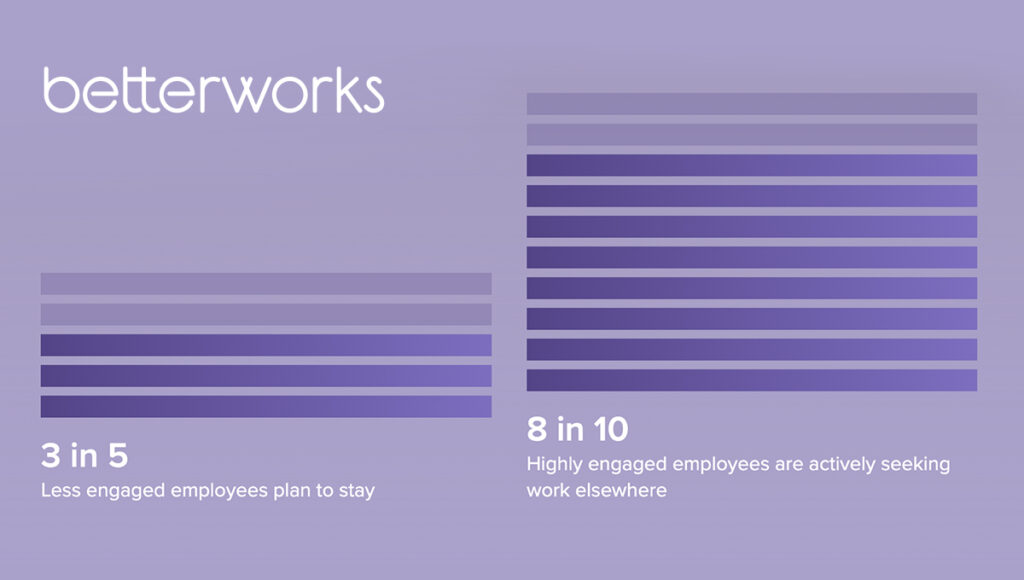
In other words, your top innovators who are using generative AI to drive productivity and innovation might be eyeing the exit, while AI laggards are more likely to stick around. If left unaddressed, this growing gap threatens to drain innovation and slow your company’s progress and ability to remain competitive in the long term.
The cost of employee turnover
Losing good people is expensive — both financially and in terms of individual satisfaction and team morale and momentum. Consider these figures:
- Longer-term talent success: Less than one-third (32%) of employers have the strategic people capabilities to build a “talent advantage” connected to better productivity and business outcomes, according to EY’s 2024 Work Reimagined Survey. Among the five factors that encompass this advantage are work technology and generative AI.
- Replacing talent isn’t cheap: Replacing an employee costs roughly 1.5 to 2 times their annual salary. It can be even higher for specialized or senior roles. This includes recruiting, training, and lost productivity costs — ouch.
When a star employee walks out the door, you don’t just lose their output — you lose institutional knowledge, client relationships, and leadership on projects. You have to invest time and money to find and train a replacement. It’s a hit to the bottom line that most organizations would rather avoid. That’s why addressing any emerging retention risk, like the AI adoption gap, is so important for HR leaders.
The link between AI use, hope, and fear
For employees who embraced AI tools in their day-to-day work, AI profoundly changes the way people work. They report higher productivity, greater creative output, improved work quality, and better alignment with goals.
In Betterworks’ 2025 survey, 87% of daily AI users say AI makes them more productive, yet 93% believe they’re barely tapping into AI’s full capabilities. In other words, power users are optimistic — they see huge opportunities for career growth by leveraging these new skills and tools. They feel ahead of the curve and excited about what AI can do for them. However, their optimism is tempered by a palpable undercurrent of anxiety. The same people who are gung-ho about AI also understand its disruptive power — and some are scared. Paradoxically, many AI-savvy employees worry about the very technology they champion. In fact, 49% of employees enthusiastic about AI also fear that it will replace them and they are 3x more worried about losing their jobs due to AI.
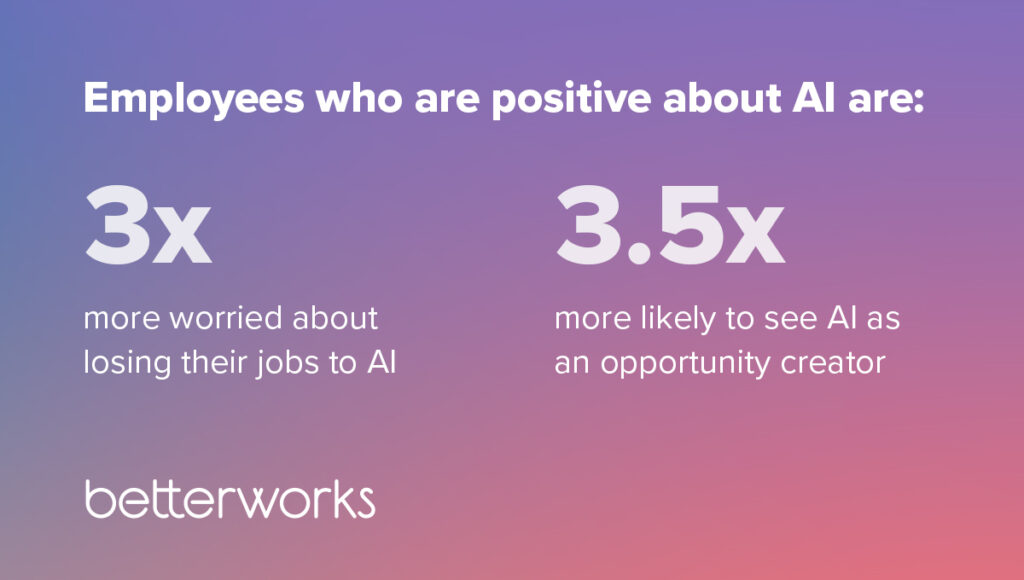
They recognize that AI could reshape job expectations or even eliminate roles, especially during times of restructuring. This “AI anxiety” creates tension in the workplace: people see the career opportunities and the risks. By contrast, employees who use AI less frequently are far less concerned about being replaced—perhaps because they haven’t fully grasped AI’s impact yet or because they assume their roles aren’t threatened. The Betterworks study reveals that less than one-third of workers who plan to stay in their roles are worried about AI, and only 1 in 6 of those who plan to stay think it’s important to keep their skills up to date.
Meanwhile, a significant portion of the workforce remains on the sidelines altogether: about one-third of employees don’t understand how AI can help in their role, and roughly one-quarter say they lack training on how to use it effectively and don’t know how to utilize AI in their role. A paltry 8% of workers who plan to stay in their roles view AI positively, compared to nearly 60% who are looking for work. The Betterworks survey also found that negativity toward AI is far higher among employees who don’t have access to the right AI tools.
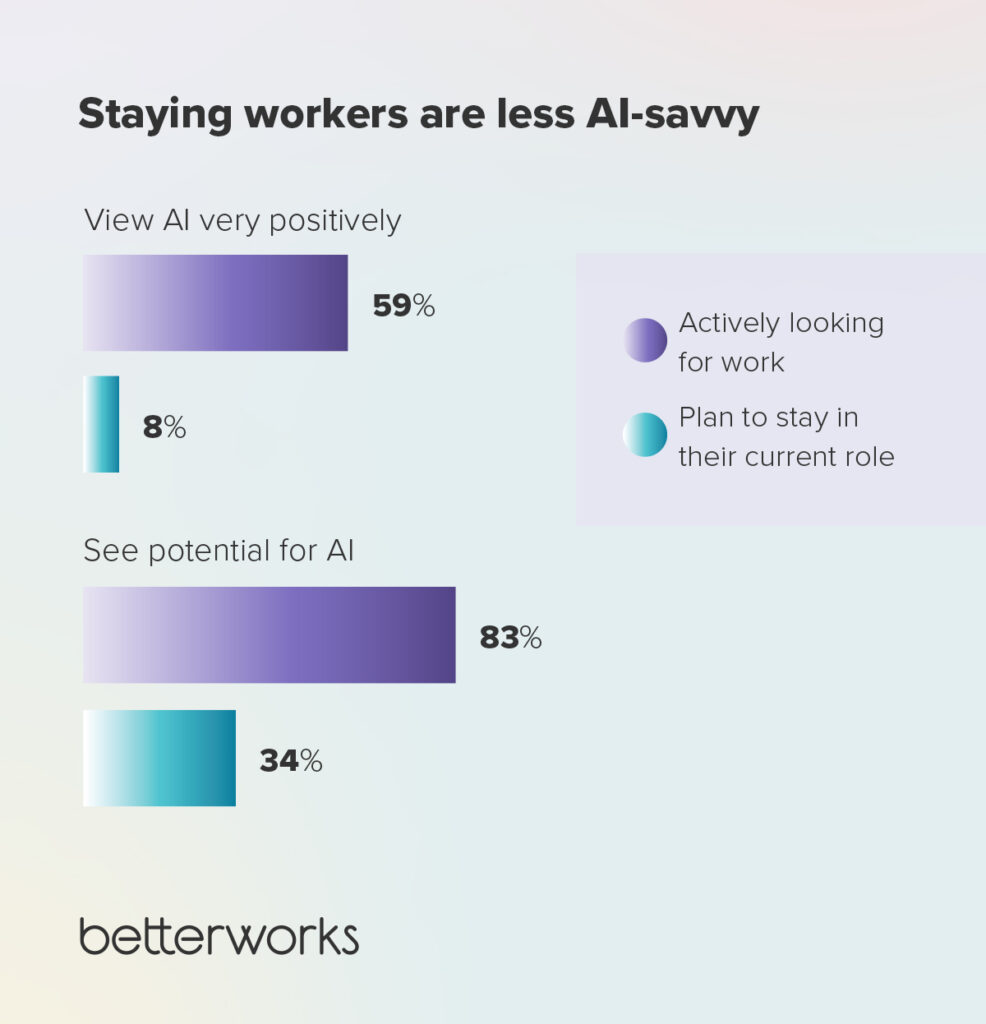
The growing gap between leaders and everyone else
This divide — enthusiasm vs. apprehension, early adopters vs. the uninitiated — is creating an “AI hope-and-fear” split among employees. The dichotomy falls along role or seniority lines. Executives and senior leaders are far more likely to be AI power users than everyone else according to the survey findings. The Betterworks report found that senior leaders are twice as likely as managers, and 3.5x more likely than individual contributors, to regularly use AI at work.
So you’ve got tech-savvy leaders charging ahead, while many lower-level haven’t caught up or bought in. Without intervention, this imbalance can breed frustration on both sides — early adopters may feel held back by an organization that isn’t keeping pace, and less engaged employees might feel increasingly left behind or fearful as AI skills become more critical.
“Engage employees at all levels to help co-create a future of work powered by AI,” says David Landman, talent strategist and former global HR leader for Goldman Sachs. “Foster innovation by encouraging experimentation, asking employees to reimagine their roles in an AI-augmented world, and sharing lessons from successes and failures.
Improving retention by using AI to bolster careers
One of the biggest reasons employees leave is feeling like their careers have stalled out. If people can’t see growth opportunities at your company, they’ll look for them elsewhere. Career stagnation is a top driver of attrition. Studies have shown that lack of advancement or skill development ranks high among reasons for quitting. Betterworks’ 2023 State of Performance Enablement survey found that 75% of employees said they’d prefer to stay and grow with their current employer, but less than half could see a clear path for advancement internally. Given that “internal career advancement” was the second highest reason employees said they’d stay at a company, employers can’t afford to let people’s growth ambitions wither on the vine.
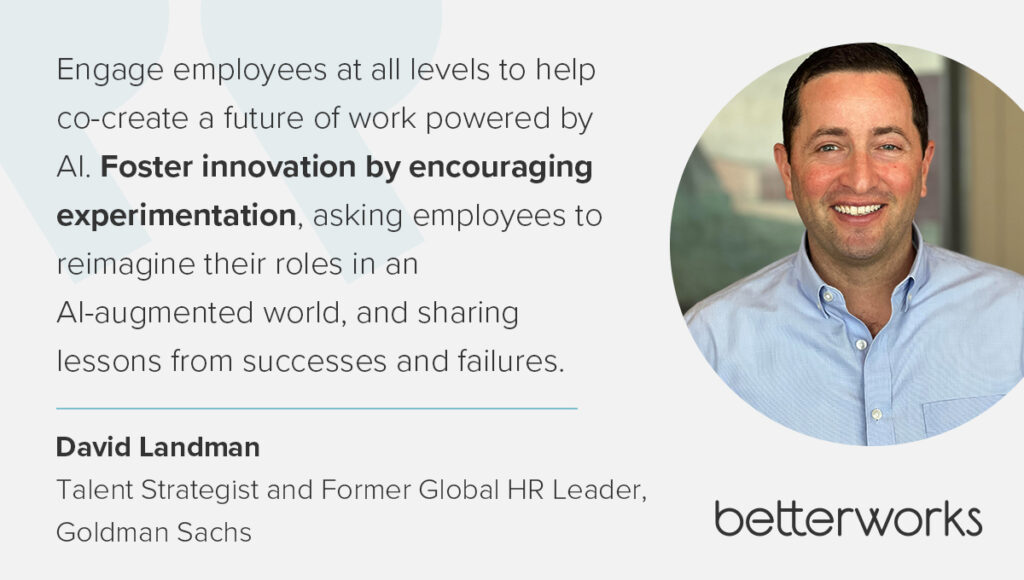
Let AI identify career paths, skills, and opportunities
Here’s where AI can make a positive impact. The same technology causing some anxiety can also be harnessed to boost employees’ career development in very tangible ways. Modern HR tech tools — often powered by AI and machine learning — can help employees map out personalized career paths, identify skill gaps, and even recommend internal job opportunities or projects that align with their goals. A majority of all employees —two-thirds more more — say they’d like AI’s help with these activities.
AI-driven career pathing platforms can, for example, analyze an employee’s skills, interests, and performance and then suggest roles or training that could move them toward their desired career destination. This year’s report shows that two-thirds or more of employees would actually welcome AI’s help with upskilling and internal mobility.
AI tools can surface internal opportunities — say, a stretch assignment or a job opening in another division — that an employee might not have been aware of, but would be a great fit for. The goal is to leverage AI to make career development more proactive and personalized for everyone, not just the squeaky wheels. When people feel like they’re growing and moving forward in their careers, they’re far less likely to walk out the door.
By democratizing AI access and skills across the workforce, you also empower more employees to take charge of their growth. AI experimentation, training, or upskilling, for example, can be included as a development goal in an employee’s performance management plan.
How to improve retention with an AI action plan
If uneven AI adoption is a looming “brain drain” threat, the good news is HR leaders can take steps to close the gap and calm those retention risks. Here’s a practical game plan:
- Democratize AI skills and tools. Betterworks executives have identified integrating AI into work as one of the top 10 challenges for leaders in 2025. You can help teams build AI into their daily workflows. Don’t let AI capabilities live only at the top or in select teams. Provide training and appropriate AI tools for employees at all levels. When everyone gets a chance to build AI literacy, you boost overall productivity and reduce the intimidation factor that causes some employees to shy away.
- Embed AI into career growth and internal mobility. Make AI proficiency a core performance goal for all employees and create the time for them to learn and use AI as part of their workday. Promote AI experimentation or training as a development goal and track progress through your performance management system. You may even want to consider tying AI skills to internal mobility opportunities.
- Address the “AI anxiety” head-on. Don’t ignore the elephant in the room – talk openly about how the organization plans to use AI and how it will impact jobs. Nearly half of AI enthusiasts fear job displacement. Reassure your workforce that AI is there to augment their work, not replace them, and back up those words with actions. When employees trust that AI is being implemented thoughtfully (and not as a stealth layoff strategy), they’ll have more confidence in staying put and upskilling for the future.
- Leverage managers as AI champions. Managers are usually the most knowledgeable about their teams’ needs and concerns. Engage them to adopt and model effective AI use to boost their teams’ productivity and help them deliver measurable business outcomes.
Moving forward with AI in the workplace
Uneven AI adoption in the workplace is a new wrinkle in the retention challenge, but it can be managed with the right approach.
By embracing AI, developing a structure and plan for using AI safely, and promoting its sensible use across the workforce, regardless of role or level, HR leaders can help ensure that AI doesn’t become a dividing line between “haves and have-nots” in the organization. Instead, it becomes a rising tide that lifts all boats — enhancing productivity and showing employees a path to grow with the company. The end result? You retain your top performers and elevate overall workforce capability.
For a deeper dive into the data and strategies behind these insights, check out our digital State of Performance Enablement report, which contains a link to the full report.
Build an AI plan for retention






